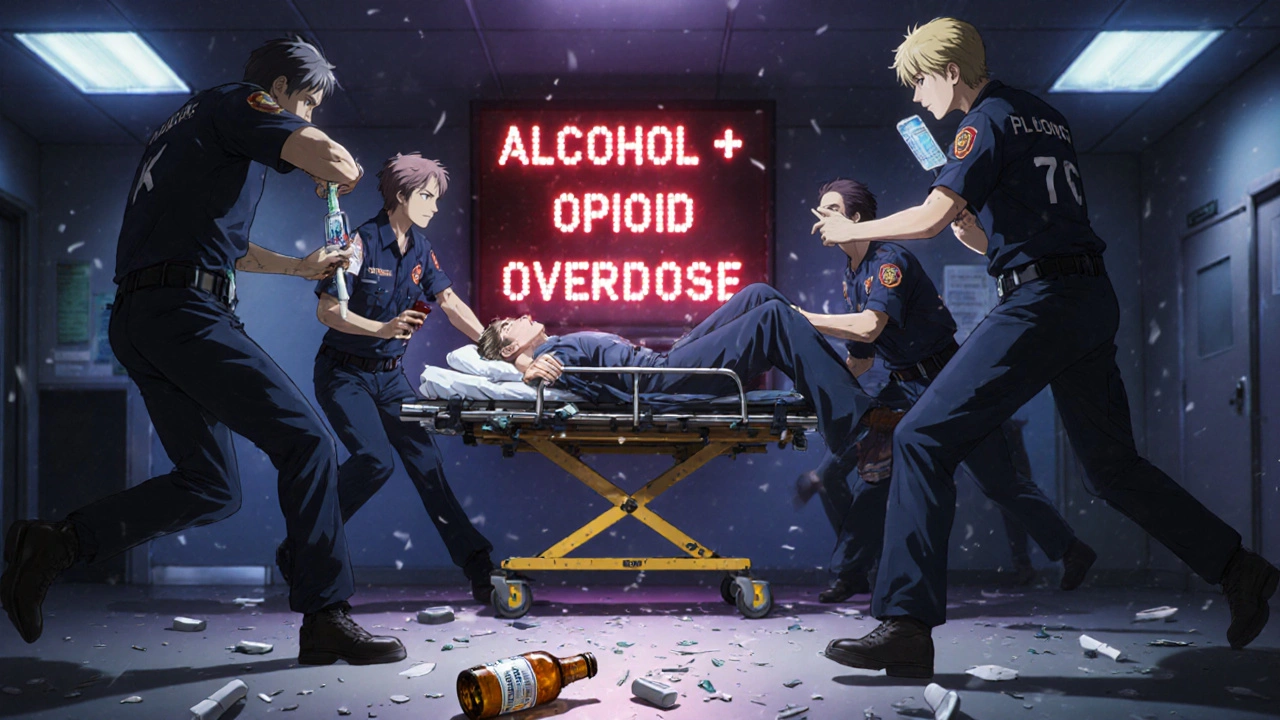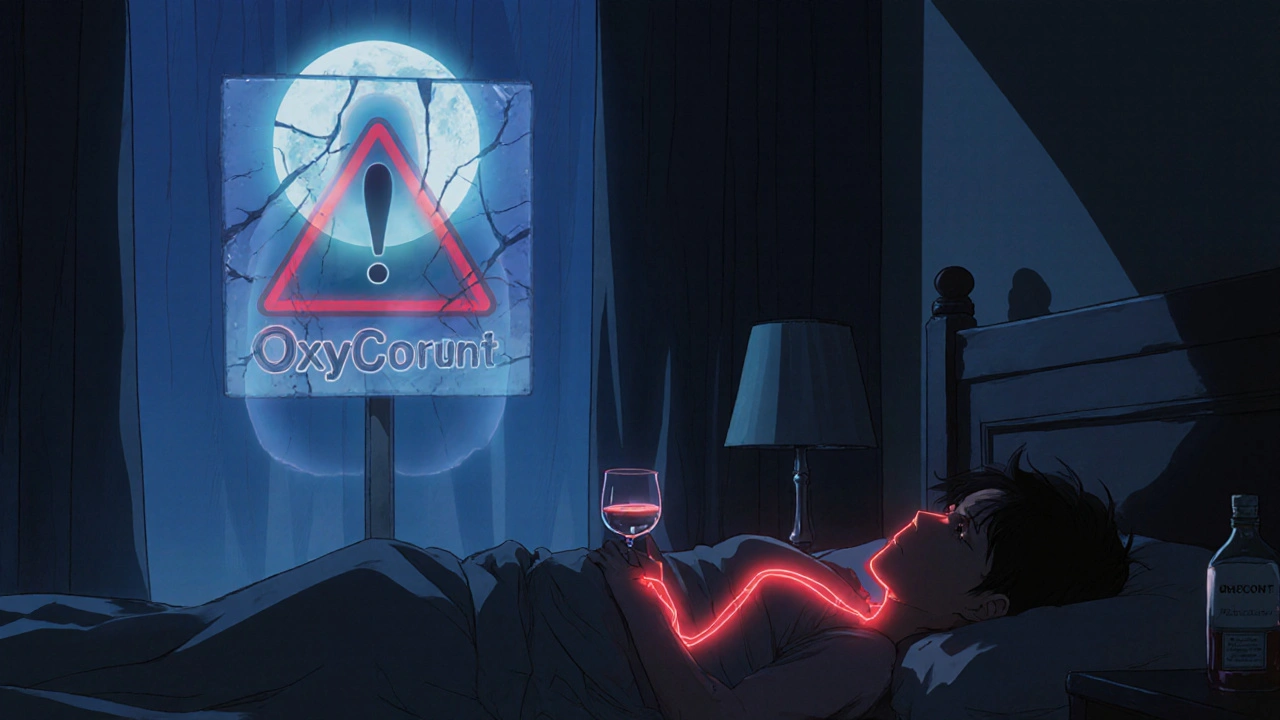Alcohol-Opioid Risk Calculator
How This Calculator Works
Based on FDA studies, this calculator estimates your risk of respiratory depression when combining alcohol and opioids. Even small amounts can be deadly.
When you mix alcohol and opioids, you're not just doubling the risk-you're multiplying it. This isn't a guess. It's science. And it's killing people every day.
Why This Combination Is So Dangerous
Both alcohol and opioids slow down your central nervous system. That’s why they make you feel relaxed, drowsy, or even euphoric. But when they’re together, they don’t just add up-they amplify each other. The result? Your breathing slows down so much that your body can’t get enough oxygen. This is called respiratory depression, and it’s the main cause of death in opioid overdoses.The U.S. Food and Drug Administration (FDA) put a black-box warning on all prescription opioids in 2016. That’s the strongest warning they can give. It says clearly: do not mix alcohol with opioids. Why? Because even small amounts of both can be deadly. A 2017 study found that 20mg of oxycodone alone reduced breathing by 28%. Add just enough alcohol to reach a blood alcohol level of 0.1%-the legal limit for driving in most U.S. states-and breathing dropped another 19%. In older adults, the risk of stopping breathing completely jumped even higher.
Who’s at Risk?
It’s not just people using street drugs. Many people who take prescribed painkillers like hydrocodone (Vicodin), oxycodone (OxyContin), or fentanyl also drink alcohol. They might not think it’s a big deal. After all, their doctor prescribed the pill. But research shows that alcohol is involved in 15-20% of all opioid-related deaths. In 2022, over 107,000 people in the U.S. died from drug overdoses. More than 80% of those involved more than one substance-and alcohol was often part of the mix.Men are more likely to die from this combination. Data from Texas between 2010 and 2019 showed that 77% of alcohol-opioid deaths were among men. But women aren’t safe either. The risk is rising across the board.
People on methadone for opioid use disorder are especially vulnerable. One study found they were 4.6 times more likely to die from an overdose if they drank alcohol. That’s not a small increase. That’s a life-or-death difference.
It’s Not Just Prescription Opioids
Fentanyl, the synthetic opioid driving the overdose crisis, is especially dangerous when mixed with alcohol. Between 2010 and 2019, alcohol involvement in fentanyl-related deaths rose from 9% to 17%. Heroin deaths also saw alcohol in 13-20% of cases. Even buprenorphine, often used to treat addiction, becomes more deadly with alcohol. One study found alcohol in 30% of fatal buprenorphine overdoses.And it’s not just alcohol and opioids. Many people also take benzodiazepines-like Xanax or Valium-for anxiety or sleep. When you add those to the mix, the risk multiplies again. In 2021, nearly 14% of opioid overdose deaths involved benzodiazepines. Add alcohol, and you’ve got a triple threat that’s hard to survive.

What Happens in Your Body
Alcohol and opioids both target the same part of your brain-the brainstem-that controls breathing and heart rate. When you take one, it slows things down. When you take both, they work together like two people pulling on the same rope, harder and harder until it snaps.Your brain stops telling your lungs to breathe. Your oxygen levels drop. Your heart struggles. You lose consciousness. And if no one intervenes, you die. Often, it happens quietly. No screaming. No struggle. Just stillness.
Post-mortem studies show that alcohol lowers the amount of opioid needed to cause death. Someone might take what they think is a safe dose of oxycodone-but with even one drink, that dose becomes lethal.
Doctors Are Trying to Stop It
The American Society of Addiction Medicine now requires doctors to screen patients for alcohol use before prescribing opioids. Why? Because people with alcohol use disorder are 3.2 times more likely to overdose on opioids. Many doctors now refuse to prescribe opioids to patients who drink regularly-even if they have chronic pain.The FDA also banned opioid cough medicines for anyone taking other CNS depressants, including alcohol. That’s because cough syrups often contain codeine or hydrocodone. Combine them with a beer or a shot, and you’re playing Russian roulette.
Some hospitals and clinics now carry naloxone (Narcan) for patients who use both alcohol and opioids. In Massachusetts, 23% of naloxone reversals in 2022 involved alcohol. That means people are still alive today because someone had naloxone on hand.

What You Can Do
If you or someone you know takes opioids for pain, addiction, or any reason, here’s the rule: do not drink alcohol. Not one drink. Not one glass of wine. Not one beer.- If you’re on prescription opioids, ask your doctor if alcohol is safe. The answer will almost always be no.
- If you’re in recovery for opioid use, avoid alcohol completely. It’s not just a trigger-it’s a direct path back to overdose.
- If you use opioids recreationally, understand that alcohol makes any dose unpredictable and potentially fatal.
- Carry naloxone. It can reverse an opioid overdose, even if alcohol is involved. Keep it with you. Teach your friends how to use it.
There’s no safe level of mixing. Not even one drink. Not even one pill. The risk starts at the very first combination.
Hope Is Still Possible
In January 2023, the U.S. government launched the “Don’t Mix” campaign with $15 million to raise awareness. Researchers at the University of Pittsburgh are developing a wearable device that can detect early signs of respiratory failure-like drops in heart rate variability-up to 30 minutes before collapse. That could save lives.But technology won’t fix this alone. People need to know. They need to understand that this isn’t about willpower. It’s about biology. Your body can’t handle the combo. No matter how strong you think you are.
The CDC predicts alcohol-opioid deaths will rise 7.2% each year through 2025 unless something changes. That’s not a forecast. It’s a warning. And the warning is clear: if you mix alcohol and opioids, you’re risking your life.
Can you die from mixing alcohol and opioids even if you don’t take a lot?
Yes. Even small amounts of both substances can be fatal. A single drink combined with a low dose of prescription opioids like oxycodone can slow breathing enough to cause death. The risk starts at the first combination-there’s no safe threshold.
Is it safe to have a drink after taking an opioid painkiller the same day?
No. Opioids stay in your system for hours-even days, depending on the type. Alcohol doesn’t need to be taken at the same time to be dangerous. The interaction can happen long after the opioid was taken, especially with long-acting forms like OxyContin or methadone.
Does naloxone work if alcohol is involved in the overdose?
Yes. Naloxone reverses the effects of opioids, even when alcohol is present. It won’t reverse alcohol poisoning, but it can restore breathing if opioids are the main cause of the overdose. That’s why carrying naloxone is critical for anyone who uses opioids or lives with someone who does.
Why do doctors still prescribe opioids if they’re so dangerous with alcohol?
Opioids are still effective for severe pain, like after surgery or cancer treatment. But doctors are now required to screen for alcohol use before prescribing them. Many avoid prescribing opioids altogether to people who drink regularly because the risk is too high. The goal isn’t to deny pain relief-it’s to prevent deadly mistakes.
What should I do if someone I know has mixed alcohol and opioids and passed out?
Call emergency services immediately. Then give naloxone if you have it. Don’t wait. Don’t try to wake them with cold water or shaking. Their breathing may have stopped. Naloxone can reverse the opioid effect, and paramedics can treat the alcohol and other complications. Every minute counts.
Are there any safe alternatives to mixing alcohol and opioids for pain or anxiety?
Yes. For pain, options include physical therapy, NSAIDs like ibuprofen, or non-opioid nerve medications like gabapentin. For anxiety, therapy, mindfulness, or non-addictive medications like SSRIs are safer. Always talk to your doctor before making changes. You don’t have to choose between pain relief and safety.


Comments
Lashonda Rene
i just want to say i used to drink and take my pain pills like it was no big deal, like i was invincible or something. i thought if i didn't get drunk, it was fine. but one night i had one glass of wine with my oxycodone and i woke up on the floor with my roommate screaming for 911. i didn't even know i passed out. the doctors said my breathing dropped to like 4 breaths a minute. i'm lucky i'm alive. now i don't even keep alcohol in the house. it's not worth it. not even one sip. i lost three friends this way and i don't want to be another statistic.
Andy Slack
THIS. RIGHT HERE. THIS IS WHY WE NEED MORE AWARENESS. NOBODY TELLS YOU THIS. I'M GLAD YOU SAID IT.
Cris Ceceris
it's wild how we treat alcohol like it's harmless while opioids are painted as the villain. but they're both CNS depressants. they're both chemicals that slow down the most basic functions of being alive. we don't think about it because alcohol's legal, but that doesn't make it safer. it just makes it more invisible. and that's what kills people. not the drug itself, but the belief that it's 'normal' to mix them. we need to stop normalizing the slow suicide of respiratory depression.
Brad Seymour
man, this is so real. i work in ER and we see this all the time. people come in with their families saying 'he just had a couple drinks and his pain meds' like it's a snack mix. it's not. it's a death sentence. i wish more doctors would sit down and actually explain this instead of just checking a box on the form. we lost a guy last month. 42, dad of two. just took a pill after a beer. never woke up. his wife still texts me asking why no one told them.
Malia Blom
so let me get this straight... we're supposed to believe that one drink + one pill = death, but i can down 12 beers and drive home fine? because apparently the law says it's okay to be drunk but not okay to be in pain? what a joke. this is just another way to shame people who need meds. if you're not a junkie, you're just a 'responsible patient' right? yeah right. they'll take your pain pills away and call you an addict while you're sobbing in the waiting room.
Erika Puhan
the data is unequivocal. the synergistic inhibition of GABAergic and mu-opioid receptor pathways results in profound suppression of the medullary respiratory centers. epidemiological analyses confirm a dose-response relationship between concurrent ethanol exposure and opioid-induced respiratory arrest. this is not anecdotal. this is biostatistical fact. if you're engaging in polypharmacy without pharmacokinetic literacy, you are not a patient-you are a liability to public health infrastructure.
Edward Weaver
we need to stop coddling drug users. if you can't control yourself, don't be allowed to have meds. alcohol is a gateway to death and the left wants to pretend it's fine. this is why america's dying. people are weak. they drink, they take pills, they die. end of story. lock up the enablers and stop giving out naloxone like candy. let nature take its course. you want to play with fire? burn.
Lexi Brinkley
THIS IS SO IMPORTANT!! 💔 I HAVE A COUSIN WHO JUST LOST HER HUSBAND THIS WAY. NOBODY TOLD HER IT WAS DANGEROUS. NALOXONE SAVED HER KID’S DOG ONCE BUT NOT HER HUSBAND. 😭 WE NEED TO SPREAD THIS WORD!!
Kelsey Veg
my ex was on methadone and drank every night. he said it 'helped him sleep.' he died in his sleep. no one knew. just found him cold. the coroner said his blood alcohol was 0.08 and his oxycodone level was 'therapeutic.' i'm still mad. no one warned him. no one warned me. now i carry naloxone everywhere. even to the grocery store.
Alex Harrison
you know what's wild? my grandma took hydrocodone after hip surgery and had a glass of wine every night. lived to 92. so... is this just fearmongering? maybe it's not as bad as they say? i mean, people have been mixing this for decades. why is it suddenly a crisis now?
Jay Wallace
Oh, please. Let’s not pretend this is about ‘public health.’ This is about control. The FDA doesn’t care if you live or die-they care if you’re compliant. They banned opioid cough syrups because they couldn’t tax them properly. They push naloxone because it’s a revenue stream for hospitals. And they tell you ‘no alcohol’ because they don’t want you thinking for yourself. You’re not a child. Stop being manipulated by fear-based propaganda.
Alyssa Fisher
what’s haunting me is how quiet this death is. no struggle. no scream. just stillness. it’s the opposite of what we imagine when we think of overdose. it’s not a messy, dramatic collapse-it’s a gentle fading. like a candle snuffed out by a breeze you didn’t feel. and that’s why it’s so easy to ignore. we don’t see it coming because it doesn’t look like danger. it looks like sleep. and that’s the most dangerous lie of all.
Alyssa Salazar
the pharmacodynamic synergy between ethanol and opioids is well-documented in peer-reviewed literature. the CYP3A4 metabolic pathway inhibition leads to prolonged opioid half-life, while ethanol enhances GABAergic tone via allosteric modulation. this creates a non-linear, exponential risk curve. the clinical implications are catastrophic. if you’re using opioids chronically, any ethanol consumption-even social-elevates your risk of respiratory arrest beyond the threshold of safe tolerance. period.
Beth Banham
i just wanted to say thank you for writing this. i’ve been sober for 3 years after losing my brother to this. i didn’t know how to talk about it until now. you made me feel less alone.